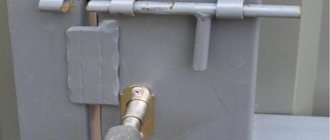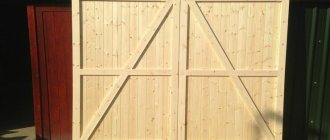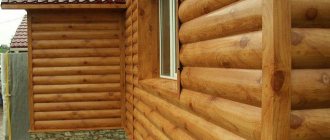Swing gates are often used for garages and courtyards of private houses. In order to lock them securely and quickly, it is important to additionally install the main security element - a gate bolt. It is easy to open and holds the doors firmly in place.
Different types of gate locks
What is a deadbolt? This is a locking mechanism that ensures reliable fixation of the gate in the closed position. A high-quality lock can significantly simplify opening/closing gates and make them more reliable. Most models are designed to be opened only from the inside without using keys, in other words, the deadbolt cannot be opened from the outside.
Principle of operation
Design options based on operating principle can be divided into several types.
Latch on a wooden door
Screw latches
A simple screw latch is attached to the outside of the gate. This model consists of a threaded rod and a release lock that has a small pin and groove. The locking mechanism is activated by a key with the required slot and a pin at the end.
You can easily make such a latch for the gate yourself. It is recommended to galvanize the finished product to extend its service life.
In the country
The complexity of this homemade design lies in the fact that there must be enough free space in the doorway for a threaded recess into which the key in the form of a rod is screwed directly. Moreover, this overhead mechanism is very easy to hack by selecting a similar key.
Overhead sliding locks
This is a mechanism that is easily attached to a flat metal profile. Due to the flat rod, such a lock ensures the strength of closing the door leaf. The mechanism can be fixed either from the inside or from the outside of the fence. For greater efficiency, you can install a padlock on the outside.
Gate bolt drawing
Rotary slot mechanism
This is a simple lock with a high efficiency and degree of protection against burglary. You can assemble the device yourself, but certain knowledge and equipment will be required. The key, which is lowered when inserted into the slot, activates the gear mechanism by circular rotation, which unlocks the sash.
Rack and pinion bolt mechanism
This product can be purchased at the Leroy Merlin retail chain. Only a specialist can make such a locking device independently. The design consists of a key with recesses and a locking base. This mechanism is highly durable and has a long service life, but there is a possibility of the key being counterfeited. Therefore, some additional lock is often used to lock the door.
The photo below shows an overhead valve.
Metal door in the fence
Mortise design for gate
This is the most popular design of locking mechanisms, sold in every hardware store. To install this lock, you need to cut a groove in the base of the sash. The reliability of such a device is very high.
Spring latches
Such structures are most often installed from the inside. They are an additional locking mechanism with a snap-on base. Their spring device makes it possible to easily activate the latch.
Device
Code lock for gate
This is a convenient lock with a high degree of security. The mechanism is activated by simultaneously pressing the keys in accordance with a preset digital combination. For reliability, it is best to change the code regularly.
Diagram with dimensions
Electromagnetic lock
Thanks to the latest technology, electromagnets are practically impossible to hack. A magnetic type lock can be purchased in stores. To install the structure, the help of craftsmen will most likely be needed.
Thanks to a reinforced magnet, powered by electricity, the closed gate is firmly fixed. When the door is locked, it closes automatically. The device is opened using a magnetic card or button.
Outdoor electric strike
Electromechanical latch
An electromechanical lock is a device that combines mechanical and electronic design. Therefore, the lock comes with 2 types of keys - electronic and mechanical. The gate is locked automatically.
An electromechanical device for a yard gate made of corrugated sheets is practically no different in appearance and design from a simple mechanical lock. The only difference between the electric latch is the installation of a special electronic unit to control the mechanism.
Electromechanical lock
There are many different locking devices that are used to protect homestead areas. Taking into account the complexity of a certain mechanism, you can purchase a lock in a store or make it yourself.
To decide on the type of latch, you can also watch the video below.
Self-closing latch
Self-closing mechanism
You can also make a latch that will latch itself. A flat, stationary metal strip must be installed on the door. When the gate is closed, the lever engages with this plate. The latch itself is secured with one bolt. And another bolt is screwed in nearby in order to limit the movement of the lever. To open such a latch, just press the lever, it will release the bar. To close the gate, it is often enough to simply push the door so that it slams.
The most common among wicket locks are horizontal latches. They are attached to all types of gates. Such constipations have a simple device, consisting of a rod, a fastening eyelet and a special holder. And the principle of their operation is similar to the action of vertical locking devices. There are different types of overhead sliding latches. The mechanism of such latches is easily attached to any canvas. The flat bar ensures sufficient security of the lock. It can be installed both internally and externally. For greater securement, you can put a padlock on the mechanism from the outside, which is installed on special lugs.
Vertical locks and latches
It is much easier to make different types of bolts than to make a deadbolt for a garage door with your own hands. For the first, you only need a piece of pipe in which you need to make cuts for the closed and open position of the bolt. For reliability, you can also weld “ears” for a padlock. In general, the disadvantage of latches is that they will not be able to tightly tighten the sash to the frame, so you will have to install additional locks.
Sea container locking mechanism
This is a very convenient design for garage swing doors, which will be appreciated by any garage owner - you will not need to bend down when opening the garage door, and it will not be difficult to make such a lock yourself:
- Weld rings with legs for a smooth pipe on the pressing leaf; they should be 1.5-1.6 cm in diameter. From the top frame of the gate, the first distance is 20 cm, and the second in the center and the third is also 20 cm, but already from the floor.
- We attach two hooks on both sides.
- We attach two clamps for hooks to the frame from below and above.
- When the pipe rotates, the hooks will securely fix the sash.
But in the middle of the pipe that will be rotated, you need to weld a piece of pipe about 0.3 m long - this will be a kind of handle for turning the bolt. You can see the same principle of operation in trucks - everything is simple, hermetically sealed, reliable.
As you can see, you can make a deadbolt for a garage with your own hands, and some things are very easy to do, but others will require you to work hard and learn how to use a welding machine. But the main advantage is that you can make a non-standard design, which will make it possible to protect the garage well.
7 best construction and furniture stores!
Barrier bolt
The design of this type of lock is quite simple, so it is often equipped with garage doors or other utility rooms.
As a material for the manufacture of a “barrier”, it is necessary to prepare a metal plate or beam. In the version using a plate, we use a padlock to secure it (for this you will need to equip hinges for it in advance).
- We attach a beam or metal plate (length 60 centimeters) to one of the gate wings using a bolt (about a third from the edge of the gate).
- In the version with timber, we take two sections of channel (length 10 centimeters) and weld them. The width of the cuts should correspond to the width of the beam, so that it fits easily. If we use a plate, an alternative to a channel will be a metal corner, which is cut off on one side (to fit the plate tightly between it and the sash) and welded.
The operation of the mechanism is based on the principle of a barrier, hence its name.
Make it yourself or buy a valve
Gate valves are often purchased, but for gates they prefer to make them themselves. And there is an explanation for this.
- The gate is used much more often, therefore, the mechanism must be durable, work flawlessly and look aesthetically pleasing.
- The design and dimensions of gates are more standard, and choosing a locking mechanism is much easier.
- Gates have more individuality: design, materials, sizes. In this case, the lock for swing gates is usually of a hidden type. As a result, beauty is in the background, safety and reliability come to the fore.
It is for all these reasons that the manufacture of gate locking devices is more demanding and is made independently, as they say, to be sure. But what type of constipation to choose is up to you to decide.
How to make a deadbolt for a gate with your own hands?
You can make a deadbolt with your own hands from both metal and wood. If it is not possible to use a welding machine, you can fasten the metal parts of the structure with bolts or self-tapping screws, even on a metal gate.
To assemble a gate lock yourself, you will need the following tools and materials:
- hacksaw for wood or metal;
- drill;
- measuring instruments;
- wooden blocks or metal rods, cuttings of water pipes, etc.;
- decorative fittings if necessary.
Pinwheel
To make a turntable, take a small wooden block (about 10 cm long, but it can be longer if necessary). Drill a hole in the middle of its flat side. Through this hole you need to drive a nail or screw a screw into the gate post.
Barrier
Cut out the movable part of the locking device from strip metal or wood so that it extends onto the post or box by about 10 cm. In this case, the part located on the door should be approximately 2 times larger. Often such devices are made ½ the width of the gate.
Drill a hole at the edge of the strip. You need to insert a self-tapping screw into it and screw it into the frame of the gate. Locking option: drill through the gate and install a rotary handle from the outside, and its pin is rigidly connected to the barrier. When you turn the handle, the latch will rise.
A bracket is placed on the post. It needs to be sloping at the top. When closing the gate, the latch will slide along the inclined part and fall into the recess on its own, locking the door. You can open it from the outside by turning the handle or using a cord attached to the free end of the latch: it is brought out to the outside of the gate.
Espagnolette
The simplest window shutter is easier to buy ready-made, but you can make it yourself from a rod and 3-4 rings. Bend the rod in the shape of the letter G. Attach 2 rings to the sash (a piece of pipe, a large nut, etc.). Insert a rod into them, move it to the position for an open gate and attach a stopper to the pin to prevent it from coming out of the rings (weld a piece of rod or other). Install 1-2 rings on the post into which the end of the pin should fit when locking the door.
Deadbolt with locking mechanism
It is made according to the same principle as the latch, but is additionally equipped with 2 ears: 1 on the moving part, 1 on the fixed rings. When closed, the holes in the lugs should line up. It will be possible to thread the lock shackle through them and secure the locking structure.
With a latch
Do-it-yourself vertical locking on the gate is made according to the latch-latch principle. Place it on the sash, aligning the lower end of the pin with the edge of the gate in the open position. After closing the sash, determine the place where the rod will fall when closing the latch. At this point, drive into the soil or pour into concrete a piece of pipe with a diameter larger than the rod. When the gate is locked and the latch is lowered, the end of the pin is securely fixed in the threshold under the leaf. To avoid stumbling when moving through the gate, the tube must be deepened flush.
In the same way, a lock is made for the top of a gate or a large gate, over which there is a box crossbar. In this case, the tube is inserted into the beam above the exit point of the rod.
Secret castle
Sometimes the canvas does not show either a hole for a key or a hole for a lock, and the gate does not open, as if there is a lock from the inside. If you examine the canvas more closely, you will find, however, that there is a valve on the reverse side. But how it closes from the outside; at first, the mechanism of this constipation is not clear. It turns out that there is a hexagonal screw head on the door. It is turned with a special hexagonal shaped key. On the inside there is a rail, which, when the bolt is turned, closes the door locking device by rotating. Such constipation is done quite easily.
A flat flat is made on the tail of the bolt using a file. A latch is attached to it, in which a slot is made for the flat.
Collect constipation like this:
- drill a special hole for the threaded section of the bolt;
- use a thick drill to make a recess for the bolt head so that it can sink into the recess on the canvas;
- on the other hand, put two washers on the bolt and press it with a nut so that the bolt head is sunken;
- The valve is placed on the prepared flat and pressed tightly with a nut.
Features and types of locking mechanisms
Modern materials and technology for manufacturing gate locks, which differ in the type of manufacture, location and method of locking, are produced by manufacturers in a large assortment.
The main types of devices are:
Horizontal constipation. it is placed at the top, center or bottom. You can do it yourself. This is the most common type of garage structure.
Horizontal gate bolt
Vertical lock. in location and purpose it is similar to the previous type.
Vertical lock in the garage
This type is best used for sliding gates. The design consists of a pipe into which a regular piece of pipe of a smaller diameter with holes is inserted. The disadvantage of the device is the lack of a tight fit of the door leaf to the frame.
Tip: To improve the fit of the sashes to the frame, the vertical lock needs to be modified.
Such gate valves can be placed on the gate leaf and frame. In this case, the direction of the tongue is done individually.
According to the locking method, locks can be:
- Rotary.
- With fixation.
- Crossbar or screw.
- Mortise locks.
"Spinner" or butterfly valve for garage
For swing gates, many garage owners want to purchase just such a lock. Its general appearance is shown in the photo.
Turntables for the garage
If you wish, you can assemble this version of the shutter yourself. In this case, it will be strong, durable, the doors will be tightly closed, and besides, you won’t have to put much effort into the device when closing or opening.
Advice: You won’t be able to purchase a turntable at any hardware store; they don’t produce them, and if necessary, the shutter can be made to order or made by hand.
The operating principle of the device is as follows:
- The crossbar is attached in the center with a through bolt.
- When turning, the crossbar fits into grooves made of bent strips or mechanically.
- It is impossible to open them from the outside.
Gate latch
This is a fairly simple and reliable design. When installing such a lock, the only problem is the presence of a small gap between the sashes. Thanks to this design device, the latch, which fits into the slide with a stop, does not allow opening the garage door.
Tip: When using such a lock, you can make the sliding system more convenient - weld a metal eyelet for the vertical entry of the latch into it at the bottom of the sash, which will make the structure reliable and guaranteed safe.
Lock for swing garage doors
To lock swing gates, you can make a design without using bolts, rivets and other fasteners that quickly fail. They are ideal for gates made of corrugated sheets.
The instructions for such a mechanism suggest choosing the desired design from two different options:
- Fastening the lock to profile pipes. This option does not have a very aesthetic appearance, but is a reliable and strong lock for any type of gate.
- A castle whose base is a corner. Its strength is not high, which does not allow it to hold heavy gates.
Lock design from a profile pipe
The shutters are attached to the frame by welding. Their number is calculated taking into account the size of the canvas. With two doors, you will need to install a device on each half.
When making a constipation:
- The location of its installation is marked.
- Select the length of the rod that will go into the ground.
- The mark of his entry is marked.
- Rods of equal length are cut.
- Small sections of a profile circle are welded to the upper part of the structure for convenient fixation of the constipations.
Advice: The length of the rods should be such that they can be pushed into the ground enough to ensure that the gate is securely locked and will not allow them to be opened without effort.
It is quite simple to make such locks for gates, their price is not high.
Screw locks
The screw mechanism is mounted on the front side of the gate. This is a fairly simple device to use.
It includes:
- Rod, with screw thread.
- A key with a base that has a notch and a small spire.
A special key with a corresponding recess and pin operates the shutter mechanism. You can make it yourself.
The disadvantages of this design may be:
- there should be enough space in the gate opening for a recess for the thread into which the rod will be screwed directly;
- Such a device is relatively easy to hack by selecting a similar key.
Drive selection
By design they are divided into two types.
Counterweight system
Suitable for canvases that are large in weight and size.
One end of the winch cable is attached to the bottom of the sash, then the cable is passed through a mechanical block located on the ceiling, closer to the opposite wall. A load (counterweight) is mounted to the other edge. When the gate opens, it lowers, and when closed, vice versa. Moreover, the mass of the counterweight should be greater than the sash itself.
The advantage of gates with such a drive is maximum security against burglary and unauthorized entry.
Articulated-lever (lever-spring)
The mechanism consists of:
- springs;
- rollers;
- levers.
Metal profile guides are mounted under the ceiling in a horizontal position along the edges of the doorway. Springs and levers are fixed at the bottom. The rollers are placed in the upper corners of the canvas.
When installing, it is important to accurately regulate the tension of the springs, to observe the vertical and horizontal when fastening the guides. Leading mounted to the ceiling
When opening, use a cable that is placed on the profile under the ceiling
The leads are mounted to the ceiling. When opening, a cable is used, which is placed on the profile under the ceiling.
When opening, the spring stretches, and the canvas on rollers moves along the guides.
The recommended distance from the ceiling to the doorway is 30 cm.
The most successful options for locking garage doors
Of all the different designs of constipation, the least reliable are latches and latches. The design of such a mechanism is simple to the point of primitiveness. Essentially, it is a metal rod in a steel cage. When the rod is moved using the side lever, the edge of the locking element fits into the slot on the adjacent leaf and blocks the movement of the gate. You can install it on the gate with your own hands in five minutes, but its resistance to burglary is extremely low, primarily due to the weak housing of the clip.
If you need a truly powerful garage clamp, you should use one of the following designs:
- Flask lock for garage doors;
- Rotating rack mechanism;
- Constipation - pinwheel;
- Bolts on welded frame.
Advice! Each option is convenient to use in its own way, but requires careful care and lubrication of the mechanism.
Flask locking systems
Structurally, the flask lock consists of two elements - a lever with a hook and a fixing loop. The lever is installed on the gate leaf or on the door; when closing, it is enough to put the loop on the hook and throw the lever until it stops. This way, a gap is selected and the garage door is pulled tightly to the door frame. You can see how constipation works in practice from the video:
In the closed position, any effort to open the flap is perceived by the thick loop-hook of the flask mechanism; to break such a fastening, a force of more than several thousand kilograms will be required.
In addition, the flask version of the garage locking device is absolutely insensitive to clogging and contamination. Making and installing such a mechanism on the gate with your own hands is not difficult.
Rotary rack locks
An eccentric or rotary lock, made in the form of a vertical tubular post mounted on the gate leaf in four support clips, is considered no less reliable. In the central part, a lever is attached to the rack, with the help of which the rack pipe can be rotated around a vertical axis. For convenience, the lever is bolted, which makes it possible to fold it by lowering it down.
A massive hook is welded onto the upper and lower ends of the pipe. Thick and short cylinders are installed on the threshold and on the top beam of the garage door frame. When the tubular post is rotated, the hook rotates around a vertical axis and engages with the cylinder at the top and bottom of the gate.
The strength of the mechanism is not inferior to the flask design, but a more complex version to make with your own hands requires the use of alloy steels and high-quality welding.
Locking pin and rod locks
Twenty years ago, a very popular design among garage owners was a locking design in the form of a pinwheel or a rotating steel rail mounted on one of the doors. To make such a lock, it was necessary to weld a rotation axis on one of the gate leaves and make two stops to fix the locking element in the closed state; most often, two pieces of steel angle were used.
To close the mechanism, it was enough to rotate the locking frame around a horizontal axis. A simple and relatively reliable device has made this design one of the most popular options among car enthusiasts. For a long time it was believed that it was impossible to open it from the outside.
The simplest schemes were, and will remain for a long time, vertical clamps installed in the upper and lower parts of one of the sashes. This scheme is very simple to manufacture; for reliable operation and door locking, special sleeves or pipe cuttings will need to be installed in the upper and lower beams of the gate frame. Over time, dirt accumulates inside the sleeves, and in winter - frozen condensation, so periodic cleaning and purging of the fastening is required.
Step-by-step instructions for making metal swing gates
Installation of metal swing gates for a garage can be done in two ways.
Option #1:
Step 1. Cutting materials: use a grinder to cut corners and pipes of the required sizes corresponding to the drawing or project.
Step 2. Assembling the double frame.
- Two vertical strips, the length of which corresponds to the height of the gate, are connected by welding to each other with horizontal jumpers (steel strips).
- Holes are drilled in the wall of the opening for fasteners, for which pins from reinforcement can be used. The minimum depth of holes is 200 mm.
- Dust the holes.
- They are filled with cement-sand mortar.
- Use a sledgehammer to hammer in the pins.
- On the protruding part of the pins, measure 50 mm and cut off the excess with a grinder. There is another option for performing this task: cut the pins flush with the frame and scald them after installing it.
- Install the frame.
- The protruding parts of the reinforcement are bent with a sledgehammer.
Installation work is performed using a plumb line and level. The second vertical pillar of the frame is installed in the same way.
Step 3. Marking the horizontal line for installing the top beam and threshold. When performing work, use a laser level.
Step 4. According to the instructions given in step No. 2, install the horizontal frame beams.
Step 5. The frame of both doors is assembled on the table. Do not forget about the need for reinforcing crossbars, which can be arranged in an x-shape, t-shape or according to the principle of horizontal jumpers. If a gate is provided, its frame is welded from the appropriate elements.
Step 6. Weld the hinges.
Step 7. Hang the sashes.
Step 8. Weld the metal sheets (sew up the sashes).
- Sheets for sash cladding must have an outlet at the top and bottom of at least 20 mm.
- The center should be covered by the overlap of one of the sashes.
Step 9. Clean the metal from the effects of welding.
Step 10. Cover with anti-corrosion primer.
Step 11. Install locks and latches.
Step 12. Paint the gate.
If necessary, insulate the doors and openings.
Option #2:
This method of manufacturing a sash frame is optimal in situations where it is not possible to build a perfectly flat horizontal surface for assembling the frame.
Step 1. Making scarves. 4 identical strips 50 cm long are cut from a metal corner. They are grabbed at several points to the frame of the opening. The scarf is an auxiliary element that will subsequently be cut off with a grinder. Therefore, continuous welding is not required.
Step 2. Cut 4 strips to make the sash frame.
Step 3. The corners prepared at the previous stage are welded to the gussets so that a “frame within a frame” design is obtained. Continuous welding is needed only in the inner corners (for sashes).
Step 4. Installation of stiffeners. If one of the doors has a gate, its frame is welded.
Step 5. Installation of canopies/hinges. Use products with a male-female connection. The “father” is fixed to the frame of the opening, the “mother” is fixed to the gate wings.
Step 6. Using a grinder, cut the frame of the doors in the middle vertically.
Step 7. Cut off the scarves.
Step 8. The doors are sheathed with sheets of metal or other material chosen at the design stage.
Vertical type deadbolts
Gate valves of this kind are often installed as auxiliary ones, to securely fix the lower part of the gate and hold the leaves in the open position. For their manufacture, a rod of durable metal with a diameter of 1 centimeter is used, which is pre-bent into an L-shape. And select an additional tube that will correspond to the diameter of the rod.
Vertical lock with return spring
The tube is welded to the bottom of the valves, insert a rod into it and build an additional hole in the ground (usually with a driven part of the tube). Additionally, you can install an additional stop on the gate so that open doors can be fixed.
Possible designs
Among all the designs of garage locks, the following can be distinguished:
- Vertical. Suitable for swing doors. A kind of hook-holder that is fixed at the base of the gate. A bolt like this is very difficult to break.
- Horizontal. The most popular retainer. Installed at the top, center or bottom of swing gates.
- Additional locking fasteners. Mounted on a gate frame or canvas.
In turn, for greater clarity, we can divide all structures into certain types:
The rotating mechanism is a vertical tubular post, which is strengthened by four support axes and a lever in the center. The design is easy to fold.
The bolt lock is quite strong and durable. There is a thread cut on it, through which a key with such notches passes. The bolt bar is held in place by a spring.
The sliding lock consists of two bars with rings. When moving one over the other and aligning the rings, a lock is inserted from the inside to secure it.
Do-it-yourself latches and spring latches
DIY valve
To make the latch on the gate with your own hands reliable, you need to be guided by the structure of the factory design. However, the easiest way to make a valve is a vertical lock. It will require two pipes of different diameters.
Important! One pipe should move freely into the other.
You need to secure a large diameter pipe to the fence with self-tapping screws. The caps from the self-tapping screws on the street side are sawed off. You need to install a groove on the gate door that will hold the bar. After this, a self-tapping screw is drilled into the small pipe and the fixing bar is sent into the large-diameter pipe; the self-tapping screw will be held by the groove. After this, the deadbolt for the gate with your own hands is ready.
Mortise valves
The locking mechanism from the mortise valve is installed ready-made. The valve is inserted into the sockets made, but special loops can be made. This valve is installed simultaneously with the handle, so it will be convenient to use.
There are also magnetic and radio-controlled models that will hold the gate until a signal is sent to the control panel.
Common problems when installing overhead gates
First of all, the following problems may arise:
The gate is jammed. There are several reasons: during installation, the rollers were assembled incorrectly, the rollers were installed, or they broke, or the protective coating was worn off
To avoid this, it is important to follow the gate manufacturer’s recommendations during installation and not to overload the mechanism.
The canvas has fallen and will not rise. This is due to a faulty torsion spring.
Only replacing it will solve the problem.
The shutter moves very slowly. There may be several reasons. This could be deformation of the canvas or guide profiles, but most often it is over-tensioned torsion springs. The problem will be resolved after adjusting the tension.
When moving, the blade creaks a lot. Pay attention to whether any debris or foreign objects have gotten into the mechanism. This may also be a signal of wear on the rollers and hinges. To prevent this from happening, you need to periodically clean and lubricate all moving elements.
Damaged parts are replaced with new ones.
Choosing the best locking system option
Garage doors, for the most part, have a standard design: two leaves attached to the frame via hinges. Accordingly, the choice of a locking system is mainly determined by the preference of the owner.
For external gates
For external gates, a latch (horizontal bolt) and a flask locking system are optimally suited. The design of the latter is quite simple, so installation of the structure is not difficult, and the mechanism will last for many years.
For swing gates
For swing garage doors, it is recommended to use a vertical deadbolt. This is due to the fact that open doors can be fixed by lowering the metal pipe. The latter will keep the garage door from gusts of gentle wind.
Recommendations
Many people think about what is better: buying a valve or making it yourself? In the case of gates, it is recommended to buy a latch, but for gates you can make a lock yourself. The explanation for this decision is simple.
- The gate is used more often, and purchased mechanisms are more resistant to mechanical damage. Such deadbolts will last a long time and look beautiful at the same time.
- In most cases, gates have standard sizes, so choosing a purchased mechanism will be easier.
- Gates are individual; various designs and materials are used for their manufacture. The result of this approach is that beauty fades into the background. The functionality of the design and its safety are more valued. Therefore, homemade valves, barriers, latches and turntables are in greater demand in this case.
When making homemade deadbolts, you can use improvised means and secondary raw materials in the form of leftover scraps of pipes or other metal products. The final choice of type of constipation depends on the owner of the site.
Advantages of self-production and place of use
Making your own locks allows you to use old spare parts and materials, save money and make a reliable design. If you have a large gate installed, but there is no locking mechanism, then you will not be able to protect the yard area, house and buildings.
If you install the lock yourself, the attacker will not know how to open it due to the non-standard design, which will protect against theft. Of course, if the thief is a professional, he will open the lock with a hairpin or a crowbar.
But still, a strong barrier will cause him inconvenience. For garden plots, homemade bolts are used.
To protect a more valuable place - the garage, locking bolts are used in combination with padlocks. And for private homes, the most complex options are suitable: barriers, padlocks and electronic locks.
Categories of devices can be used to protect the territory:
- Regular latches, latches, etc. They cannot protect against burglary, but they will prevent opening and secure the closed position.
- Container category - they are large and durable. Suitable for sliding and swinging sashes.
- Mechanisms produced for hangars. They lock heavy doors that other devices cannot handle.
- Systems equipped with electric drive and alarm. They are suitable for private homes.
Owners select the category of constipation depending on the required functions. Often the private sector does not require signaling; container mechanisms are sufficient.
What might you need?
Despite the fact that the modern market is represented by a large selection of deadbolts and locks, many people strive to make them themselves. This is due to the fact that the locking mechanism, created independently, is an individual device, which can increase the security of the territory.
The design of the deadbolt directly depends on the dimensions of the gate, the material of the locking product itself and a number of other characteristics.
Today we can distinguish the following options for sliding elements.
- Turntables. This is the name for constipations, in the middle part of which there is an axis of rotation. During rotation, the devices are locked by both doors, providing reliable protection.
- Barriers. A subspecies of turntables. Moreover, the axis of rotation of such locks is located not in the middle, but at the edge of the bolt.
- Espagnols. This category also includes valves. Such devices are considered the most popular due to their low price and ease of manufacture. Espagnols are great for wicket maintenance. With help, it is possible to fix the gate leaves in the required position. Sometimes the structure is strengthened using padlocks.
- Locking bolts. Used for fixing the doors of large vehicles.
- Flask locks. The advantage of such devices is their high reliability. With their help, you can quickly close the gate and provide the necessary security.
Manufacturers also produce locking devices, the principle of which lies in the fact that the doors are hidden when the handle is turned. This mechanism is also used on safes. At the same time, it is possible to achieve fixation of the valves in the desired position. Almost any device can be made independently using available materials.
Main types of latches
Garage gate latches vary in design. Some of them can be done independently without significant difficulties. Others are best purchased in a store or ordered from a specialized company.
Horizontal latch
Horizontal latches are most widespread. Suitable for locking gate leaves and gates. The design of the devices is simple: a rod, a fixing ear and a holder.
Image No. 1: diagram of a simple horizontal latch
Latches are installed on the outer and inner sides of the sashes. For maximum protection, you can attach a lock to the mechanism; for this purpose, special ears are welded onto the lock.
Vertical latch
Photo No. 2: vertical gate lock
This design has also become widespread. The latch for swing gates securely fixes the doors. The locking function is performed by a metal rod curved in the shape of an “G”. When closed, it goes into recesses in the floor or ceiling.
Image No. 2: this is what the vertical lock looks like on the general diagram of swing gates
The convenience of a vertical latch is that it is not visible from the outside of the structure. This feature makes it more difficult for an attacker to enter your territory.
Self-closing latch
Photo No. 3: self-closing latch on the gate
To make a latch that will latch itself, you need to attach a fixed metal strip to the sash. If the gate is closed, the lever clings to the plate and prevents the gate from opening. The latch is attached to one bolt. The second one is screwed in nearby to limit the mobility of the lever. To unlock the door, you simply press the lever that releases the bar. To close the lock, slam the door.
Overhead sliding lock
Photo No. 4: overhead sliding lock
A convenient type of latch for gates and gates, which is an improved modification of the horizontal latch. The rod of such a valve is flat. The design is easily attached to any flat base and ensures reliable locking of the doors.
Secret castle
Photo No. 5: secret lock on the gate
If a secret lock is installed on the door, the key hole will not be visible from the outside. At the same time, there is a valve on the reverse side. To open it, you need to unscrew the hexagonal head of the bolt. When turned, the rail secured by it sets the valve in motion, and the doors open or close.
Deadbolt lock with rack system
Photo No. 6: bolt lock with rack and pinion system
It is better to buy such locking structures ready-made. The lock consists of a key with recesses and a base. Its main advantage is its extended service life and high strength indicators. There is also a drawback: the key can be easily faked if desired, so in addition to the deadbolt lock, you need to install a mortise lock.
Image No. 3: deadbolt lock diagram
Spring-based espagnolette
Photo No. 7: latch with a spring base
An espagnolette for sliding gates, which has a spring base, will be a good addition to a combination or mortise lock. The spring simplifies the process of opening/closing the doors. Most often, such structures are installed from the inside.
Image No. 4: diagram of a latch with a spring base
Video description
And here is an interesting video about a powerful barrier bar made from remnants of reinforcement.
trap devices on their gates that automatically block the gate. The most basic version consists of a metal tube with a plate attached to it. At the slightest movement of the gate, the bracket attached to it raises the pawl, which blocks the device.
Of course, every gate latch requires maintenance and care. In our climate, metal appliances can rust and wooden parts can crack. Therefore, constipations and their parts are lubricated. Dirt is cleaned from the holes, and condensation in the cold season.
There are numerous options for enhancing protection using additional mechanisms. The most common types of locks are all kinds (padlocks, grooves, overhead locks) or various screw mechanisms. A more modern option is various devices with a code system.
A modern garage lock “with a trick” - despite its apparent simplicity, opening it can be problematic, and only if you know in advance the type of lock Source rozetka.ua
The most successful options for locking garage doors
Of all the different designs of constipation, the least reliable are latches and latches. The design of such a mechanism is simple to the point of primitiveness. Essentially, it is a metal rod in a steel cage. When the rod is moved using the side lever, the edge of the locking element fits into the slot on the adjacent leaf and blocks the movement of the gate. You can install it on the gate with your own hands in five minutes, but its resistance to burglary is extremely low, primarily due to the weak housing of the clip.
If you need a truly powerful garage clamp, you should use one of the following designs:
- Flask lock for garage doors;
- Rotating rack mechanism;
- Constipation - pinwheel;
- Bolts on welded frame.
Advice! Each option is convenient to use in its own way, but requires careful care and lubrication of the mechanism.
Flask locking systems
Structurally, the flask lock consists of two elements - a lever with a hook and a fixing loop. The lever is installed on the gate leaf or on the door; when closing, it is enough to put the loop on the hook and throw the lever until it stops. This way, a gap is selected and the garage door is pulled tightly to the door frame. You can see how constipation works in practice from the video:
In the closed position, any effort to open the flap is perceived by the thick loop-hook of the flask mechanism; to break such a fastening, a force of more than several thousand kilograms will be required.
In addition, the flask version of the garage locking device is absolutely insensitive to clogging and contamination. Making and installing such a mechanism on the gate with your own hands is not difficult.
Rotary rack locks
An eccentric or rotary lock, made in the form of a vertical tubular post mounted on the gate leaf in four support clips, is considered no less reliable. In the central part, a lever is attached to the rack, with the help of which the rack pipe can be rotated around a vertical axis. For convenience, the lever is bolted, which makes it possible to fold it by lowering it down.
A massive hook is welded onto the upper and lower ends of the pipe. Thick and short cylinders are installed on the threshold and on the top beam of the garage door frame. When the tubular post is rotated, the hook rotates around a vertical axis and engages with the cylinder at the top and bottom of the gate.
The strength of the mechanism is not inferior to the flask design, but a more complex version to make with your own hands requires the use of alloy steels and high-quality welding.
Locking pin and rod locks
Twenty years ago, a very popular design among garage owners was a locking design in the form of a pinwheel or a rotating steel rail mounted on one of the doors. To make such a lock, it was necessary to weld a rotation axis on one of the gate leaves and make two stops to fix the locking element in the closed state; most often, two pieces of steel angle were used.
To close the mechanism, it was enough to rotate the locking frame around a horizontal axis. A simple and relatively reliable device has made this design one of the most popular options among car enthusiasts. For a long time it was believed that it was impossible to open it from the outside.
The simplest schemes were, and will remain for a long time, vertical clamps installed in the upper and lower parts of one of the sashes. This scheme is very simple to manufacture; for reliable operation and door locking, special sleeves or pipe cuttings will need to be installed in the upper and lower beams of the gate frame. Over time, dirt accumulates inside the sleeves, and in winter - frozen condensation, so periodic cleaning and purging of the fastening is required.
We draw up a detailed diagram of the future product
Having obtained all the necessary measurements and thought about the quantity and size of the material, it is time to draw up a detailed drawing. For this you can use ready-made drawings. You can also show your imagination and engineering abilities, if any, and draw a sketch for your personal project.
And if you have experience working with graphic computer programs, you can design a model of a garage door in a three-dimensional image. This way, you will have the most complete idea of the future product.
However, in this case you need to be especially careful and understand that for swing gates it is important to correctly calculate the strength of the supporting beams for the frame. Metal racks must be strong and withstand the load of sliding sashes
In order for the structure to be built according to the rules and to serve for many years, it is better to use various variants of drawings and, based on them, create the most complete drawing of swing gates that suits your parameters. Also, from a practical point of view, it is convenient to draw up separate sketches for the main parts of the future garage door.
So, start by drawing an image of the frame design for the garage opening. It should consist of four supporting metal beams or corners on which special fasteners (ears) are attached for installation.
These fastening elements are mounted in the opening, and the reliability of all garage doors depends on them. The most understandable and correct drawing of the frame is presented below.
Garage door frame drawing
Based on this diagram, you only need to substitute your measurements. After forming a sketch of the frame, proceed to the general drawing. On a large “A3” sheet, using a pencil, ruler and corner, draw a diagram in accordance with the numbers obtained after measurements.
Please note that the most complete diagram of swing gates should contain an image of the entire structure, and in the lower left part of the sheet the names of all parts, their parameters, and the sequence of actions should be indicated. The most informative drawing for example is shown below.
Complete drawing of a garage door
As you can see, based on the image, you can develop a plan for your future garage door with precision down to the smallest particles. You can immediately mark the places where handles, bolts and additional locks will be located.
Pay special attention to the gaps between the elements of the structure; they must comply with the standards. As a result, the finished garage door leaves should open smoothly, and the hinges should not emit any unpleasant squeaks.
Thus, taking into account all these points, you can draw up a complete diagram of swing gates with your own hands. The main thing is to take the most accurate measurements of the garage opening before drawing up the drawing, think through all stages of the work as fully as possible, formulate a draft diagram and decide on the required amount of material.
Only after resolving all these issues can you begin to draw up a final version of the drawing.
Exterior view of finished garage doors
The finished structure must be integral and take into account possible force effects during use, so pay special attention to the preparatory stage. If problems arise in the process of forming a sketch drawing, look at additional information sources, where you may find practical advice
As a last resort, seek assistance from a competent engineer.
If problems arise in the process of forming a sketch drawing, look at additional information sources, where you may find practical advice. As a last resort, seek assistance from a competent engineer.
Locking direction
If you manage to make a gate with your own hands, then installing a lock on it will also not be difficult.
Devices can be divided into 2 main types based on this criterion. Latch in warehouse
Vertical latches
An effective gate latch that provides the most reliable locking of the system. Basically, this type of locking mechanism is installed on swing structures. To secure the door leaf in the closed state, a handle with a steel rod is used, which fits into a recess made in the ground.
Vertical lock for wickets and gates
These latches are also used in mortise sashes, but in a miniature size. To secure the top and bottom of the gate opening, steel mating fasteners with a hole for the bolt rod are installed.
But when installing a lock from below, fixation is carried out by a hole in the ground filled with cement screed. If desired, you can install a double-sided latch on the gate.
Scheme for making a lock for a gate
Horizontal overhead valves
These are the most common locking mechanisms used in all types of gates and wickets. The principle of operation is approximately the same as that of the vertical closing method. The latch itself is made from a metal rod or plate, a locking eye and a holder. Popular factory models include the gate lock NOEZ ZK-230-S (black, matte).
The photo shows a door in the country house.
Installation option
Latch-trap
This device has a rather complex design, since the fixation occurs automatically. All you need to do is bring the canvas to the fixer, and he, in turn, will do the job.
For manufacturing you will need a 50/30 mm profile pipe, a metal plate about 30 cm long and 5 cm wide.
1. To begin with, the profile pipe is buried in the ground. To make the structure more reliable, it is better to concrete it to a depth of about 40 cm. A hole is first made in the pipe for a metal plate, which will later act as a retainer.
2. Next, one edge of the plate is made into a cone, a small plate is welded to it, which protrudes 20 mm beyond its edge and makes the element look like a hook. Then holes are drilled on the other side and in the middle, one of them will serve for its fastening, and the other for the spring.
3. When the profile pipe is completely installed, the prepared clamp is screwed to it using a bolt. Then a ring is welded to the pipe at the bottom, onto which the second end of the spring clings, which, in turn, returns the latch to its original position.
4. To keep it in a horizontal position, a stopper is welded to the pipe on the spring side, which can be made from scraps of metal. To fix the garage door, it is enough to press it to the manufactured structure.
https://youtube.com/watch?v=oVd1Fmw-GSA
Board spinner
A wooden pinwheel is a simple and original solution for gates in the country. To make it, you need a long board, and the second one needs to be cut into 4 pieces.
A board is bolted to the edge of the sash. It should rotate freely around its axis. It should be placed in a horizontal position and places for fastening the staples should be marked. The easiest way to make them is from the second board. At the fastening points, gaskets are installed according to the thickness of the main lock.
When rotating, the board should fit into the wooden half-loops. Therefore, one connector faces up, the second on the opposite side faces down. For gates made of corrugated sheets, you can use a strip of rolled sheet metal.
A reliable lock will be achieved if you weld hinges on one side and lock the turntable. By attaching a handle from the outside to the axial bolt, you can freely enter the yard from the street if the gate is located far away and you have enough strength to turn the beam. The longer the locking strip, the better the gate leaves are aligned and the more difficult it is to open from the outside.
Notification as a means of protection against intrusion
At dachas, “vocal guards” of a sound alarm system are installed everywhere. Those who are more or less familiar with electricity and electronics equip windows and doors with sensitive sensors that respond to any attempts at intrusion. The same analyzers can be fixed on the gate at the entrance. The information received from them is transmitted to the general system, where it is converted into a signal. A loud tonal sound scares not only uninvited guests, but also the entire neighborhood. The more sensors, the more efficient the system, and therefore, the more expensive. But no matter how perfect it is, you still cannot do without a gate in the complex chain of receiving and processing information.











